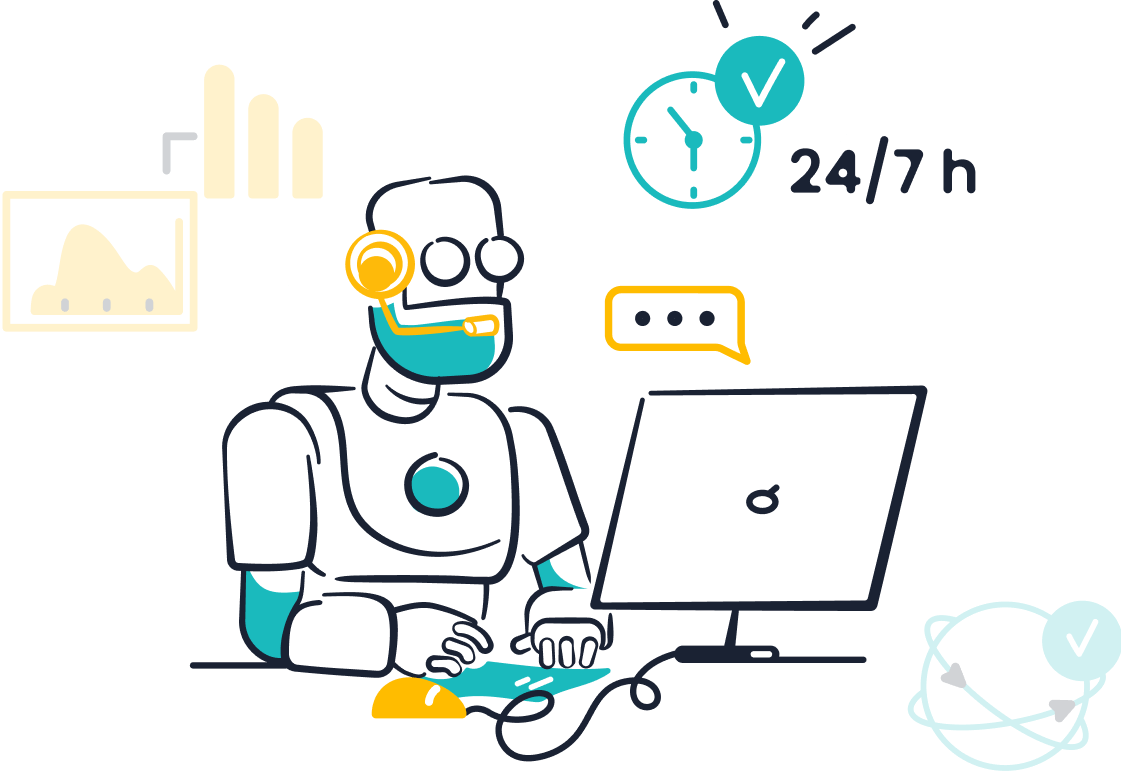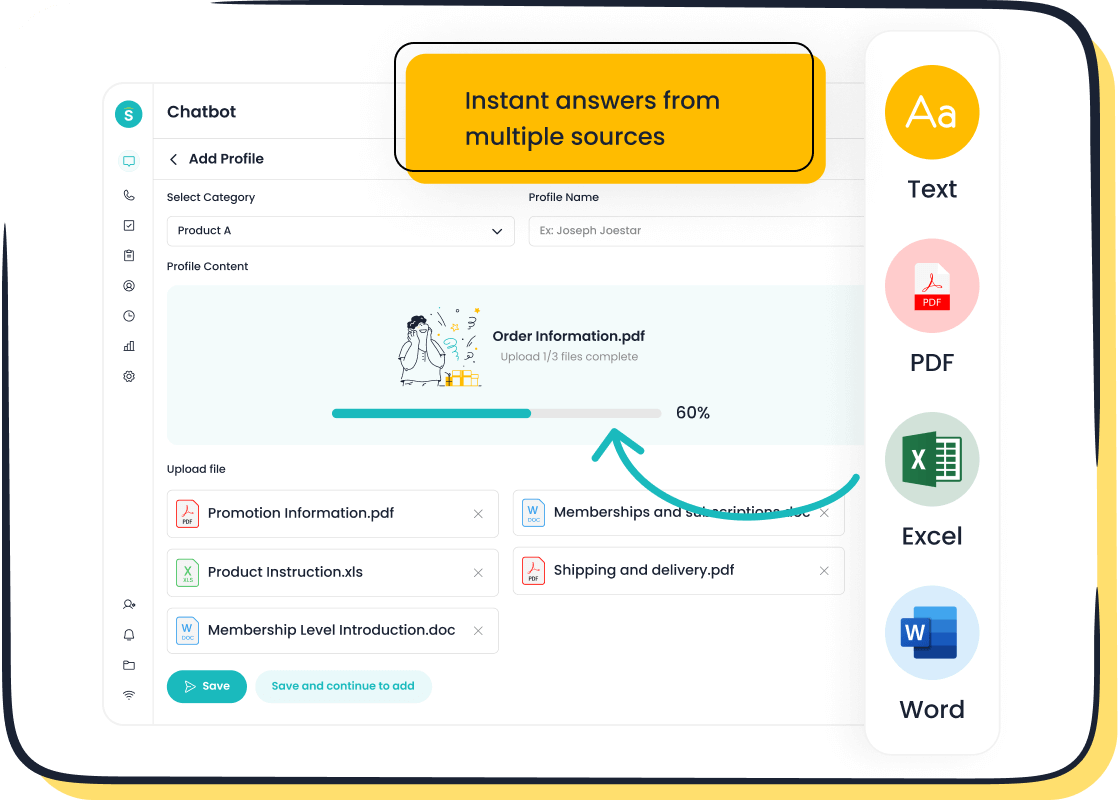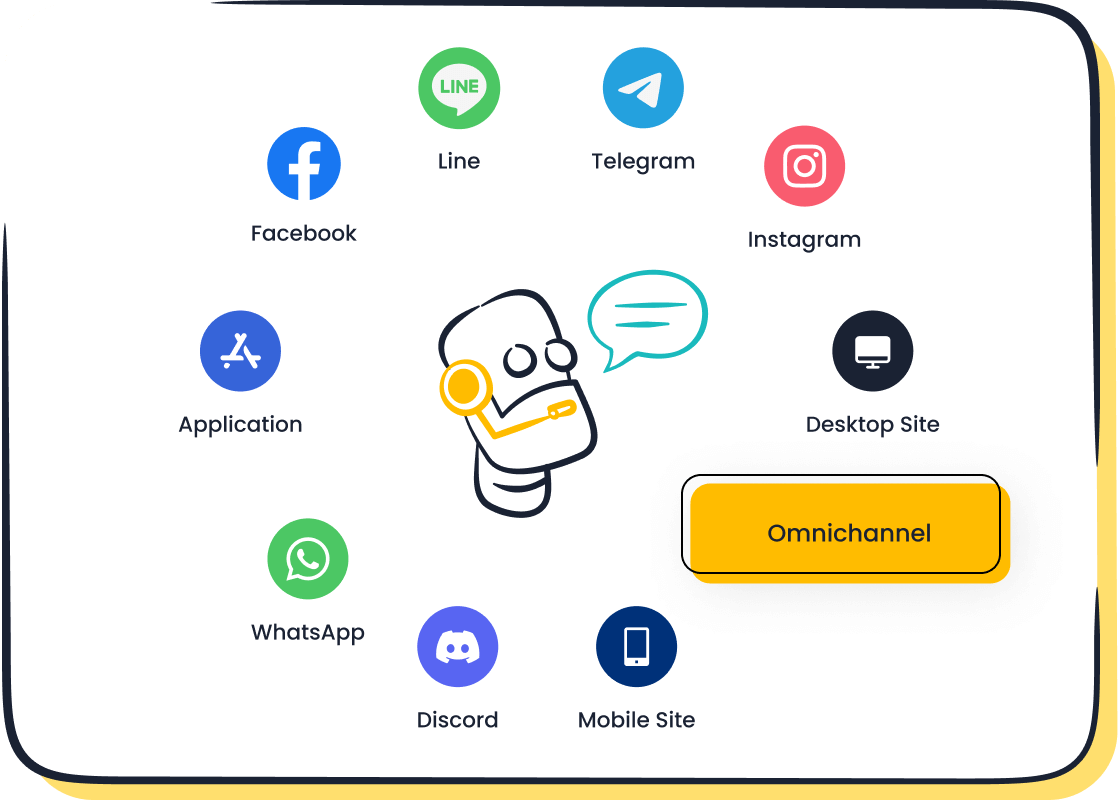Strategies to Improve Agent Performance Using AI Tools

Customer service success hinges on how well your agents perform. Metrics like Average Handling Time (AHT), First Call Resolution (FCR), and Customer Satisfaction (CSAT) reveal how efficiently and effectively your team operates. For instance, reducing AHT by 40% or improving first-contact resolution by 20% can significantly enhance customer experiences.

AI tools have transformed agent performance monitoring. They predict issues, automate routine tasks, and improve response times. Sobot’s AI-powered solutions, like its chatbot, take this a step further. By handling inquiries 24/7 and assisting agents in real time, Sobot helps you boost productivity and cut costs while keeping customers happy.
Understanding Agent Performance Metrics
Key Metrics for Agent Performance Monitoring
Average Handle Time (AHT) and its impact on efficiency
AHT measures the average time an agent spends handling a customer interaction, from the moment the conversation starts to the completion of any after-interaction work. Lower AHT often indicates higher efficiency, but it’s important to balance speed with quality. For example, if agents rush through calls to reduce AHT, it might negatively impact customer satisfaction. By monitoring AHT, you can identify bottlenecks in workflows and provide targeted coaching to improve efficiency without sacrificing service quality.
First Call Resolution (FCR) as a measure of effectiveness
FCR tracks how often customer issues are resolved during the first interaction, without the need for follow-ups. High FCR rates show that your team is effective at addressing concerns promptly. This metric directly impacts customer satisfaction and loyalty. Studies reveal that a 1% improvement in FCR can lead to a 1% increase in customer satisfaction and a 1.4-point boost in Net Promoter Score (NPS). Monitoring FCR helps you pinpoint areas where agents may need additional training or resources to resolve issues more effectively.
Customer Satisfaction Score (CSAT) and its role in customer loyalty

CSAT reflects how happy customers are with their interactions. It’s typically measured through post-interaction surveys, asking customers to rate their experience. High CSAT scores indicate that your agents are meeting or exceeding customer expectations. This metric is crucial for fostering loyalty, as satisfied customers are more likely to return and recommend your services. Tools like Sobot’s AI-powered chatbot can enhance CSAT by providing quick, accurate responses and reducing wait times.
Why Monitoring Agent Performance Metrics Matters
Enhancing customer experience through data-driven insights
Tracking metrics like AHT, FCR, and CSAT gives you real-time insights into agent performance. These insights help you identify trends, address issues before they escalate, and personalize customer interactions. For instance, if FCR rates drop, you can investigate the root cause and implement solutions, such as additional training or AI tools like Sobot’s chatbot, to improve resolution rates. Real-time monitoring also empowers agents to take ownership of their performance, boosting accountability and motivation.
Driving operational efficiency with measurable goals
Performance management becomes more effective when you set measurable goals based on key metrics. For example, reducing AHT by 10% or increasing FCR by 5% can create a structured approach to improving efficiency. These goals help balance short-term fixes with long-term improvements. AI tools, such as predictive analytics, can further enhance operational efficiency by identifying patterns and optimizing workflows. This structured approach ensures continuous improvement and better decision-making.
How AI-Driven Tools Enhance Agent Performance
Real-Time Agent Performance Monitoring
AI-powered dashboards for live tracking and insights
AI-powered dashboards revolutionize how you monitor agent performance. These tools provide real-time feedback on key metrics like call volume, resolution rates, and customer satisfaction. With this data, you can make quick, informed decisions to address issues before they escalate. For example, if customer satisfaction dips during peak hours, you can immediately adjust staffing or workflows to improve service quality.

These dashboards also transform conversations into actionable insights. By integrating AI-driven scorecards, you gain a clear view of performance trends, helping you identify areas for improvement. Tools like Sobot’s omnichannel workbench unify data from multiple platforms, ensuring you have a holistic view of your team’s performance. This level of visibility empowers you to enhance both agent experience and customer service outcomes.
Automated alerts for immediate corrective actions
Imagine receiving instant alerts when an agent struggles with a call or when unusual patterns emerge. AI tools make this possible by flagging issues in real time. For instance, if an agent’s handling time spikes, the system can notify you to intervene and provide support. These alerts ensure that small problems don’t snowball into larger issues.
Real-time monitoring tools also guide agents during interactions. They can cue agents with the correct information to resolve customer issues immediately, boosting confidence and efficiency. This proactive approach not only improves agent performance but also enhances customer satisfaction by ensuring faster, more accurate resolutions.
Predictive Analytics for Proactive Support
Identifying trends to prevent potential issues
Predictive analytics helps you stay ahead of problems. By analyzing vast datasets, these tools identify patterns and trends that might indicate future challenges. For example, reviewing service tickets or monitoring social media interactions can reveal recurring complaints. With this insight, you can address root causes before they escalate.
This proactive approach enhances customer satisfaction by reducing downtime and improving communication. Sobot’s AI-driven tools excel in this area, offering predictive capabilities that help you anticipate customer needs and streamline operations. By preventing issues early, you save time, resources, and maintain a seamless customer service experience.
Optimizing workflows for better agent productivity
AI doesn’t just identify problems—it helps you solve them. Predictive analytics optimizes workflows by suggesting adjustments based on historical data. For instance, it can recommend reallocating resources during peak hours to handle higher call volumes. This ensures your agents remain productive without feeling overwhelmed.
Enhanced personalization is another benefit. Predictive tools tailor recommendations to individual agents, helping them perform at their best. By streamlining processes and reducing inefficiencies, you create a more effective and satisfying work environment for your team.
AI-Driven Personalization in Training
Tailored coaching programs based on agent behavior
Personalized training programs are game-changers for agent performance management. AI tools analyze agent behavior to identify skill gaps and create tailored coaching plans. For example, if an agent struggles with resolving technical issues, the system can recommend targeted training modules.
These programs improve engagement by customizing content to individual needs. They’re also scalable, adapting to both small teams and large organizations. Sobot’s AI-powered solutions leverage data-driven insights to make training more effective, ensuring your agents are always prepared to deliver exceptional customer service.
Adaptive learning for continuous skill development
Traditional training methods often fall short because they don’t cater to unique learning styles. Adaptive learning changes that. By tailoring training to individual needs, it ensures agents acquire the specific skills they need to excel. For instance, if an agent excels in communication but struggles with technical knowledge, the system focuses on the latter.
This approach not only enhances skill development but also boosts agent confidence. Sobot’s AI tools identify areas where agents need improvement, providing targeted resources for continuous growth. With adaptive learning, your team stays ahead in a fast-evolving customer service landscape.
Sobot's Chatbot: A Game-Changer for Agent Assistance
Automating routine inquiries to reduce agent workload
Handling repetitive questions can drain your agents’ energy and time. That’s where Sobot’s AI-powered chatbot steps in. It takes over routine inquiries, like order tracking or FAQs, allowing your team to focus on more complex customer needs. This automation doesn’t just save time—it boosts productivity by up to 70%. Imagine how much more your agents could accomplish when they’re not bogged down by repetitive tasks.

Sobot’s chatbot operates 24/7, ensuring customers always get answers, even outside business hours. For example, Agilent, a global leader in life sciences, saw a sixfold increase in efficiency after implementing Sobot’s chatbot. By automating routine tasks, they reduced costs by 25% and achieved a 95% customer satisfaction score. This shows how AI-driven tools can transform agent performance and improve overall service quality.
Providing real-time information to enhance agent efficiency
When agents have instant access to the right information, they perform better. Sobot’s chatbot acts as a real-time assistant, delivering accurate data during customer interactions. Whether it’s pulling up order details or suggesting solutions, the chatbot ensures agents have what they need at their fingertips. This reduces response times and improves resolution rates.
The chatbot’s integration with various platforms, like WhatsApp and SMS, makes it even more powerful. It unifies customer data, so agents don’t waste time switching between systems. This seamless access to information enhances agent performance monitoring and ensures your team delivers exceptional service. With AI tools like Sobot’s chatbot, you empower your agents to work smarter, not harder.
Top AI Tools for Improving Agent Performance
AI-Powered Call Analytics Platforms
Features like sentiment analysis and keyword tracking
AI-powered call analytics platforms are revolutionizing how you monitor agent performance. These tools analyze customer interactions to uncover valuable insights. Features like sentiment analysis help you gauge customer emotions during calls, while keyword tracking identifies recurring topics or issues. For example, if customers frequently mention "delivery delays," you can address this proactively. Platforms like CallMiner and NICE offer these capabilities, enabling you to fine-tune your customer service strategies.
Benefits for training and quality assurance
Call analytics platforms don’t just collect data—they help you act on it. By analyzing call recordings, you can identify areas where agents excel or need improvement. This makes training more targeted and effective. For instance, if an agent struggles with handling escalations, you can provide specific coaching. These tools also ensure quality assurance by flagging compliance issues or missed opportunities, helping you maintain high customer satisfaction levels.
Virtual Assistants and Chatbots
Sobot's Chatbot for 24/7 support and multilingual capabilities

Virtual assistants and chatbots are game-changers for customer service. Sobot’s AI-powered chatbot stands out with its 24/7 availability and multilingual support. Whether your customers speak English, Spanish, or Mandarin, the chatbot ensures they get the help they need. It handles thousands of inquiries simultaneously, reducing wait times and improving customer satisfaction. Plus, it integrates seamlessly with platforms like WhatsApp and SMS, making it a versatile tool for modern businesses.
Automating repetitive tasks to free up agent time
Chatbots excel at automating repetitive tasks, freeing your agents to focus on complex issues. They handle FAQs, collect customer data, and even process orders. This reduces errors and boosts agent morale. Imagine your team spending less time on mundane tasks and more on strategic initiatives. Sobot’s chatbot has helped companies like Agilent achieve a sixfold increase in efficiency, proving how AI-driven tools can transform agent performance.
Workforce Management Tools
AI-driven scheduling and forecasting for optimal staffing
Workforce management tools powered by AI take the guesswork out of scheduling. They analyze historical data to predict call volumes and recommend optimal staffing levels. Tools like eResource Scheduler provide real-time availability reports, ensuring you have the right number of agents during peak times. This not only improves agent experience but also enhances customer satisfaction by reducing wait times.
Ensuring agent availability during peak times
AI tools ensure your team is always prepared for high-demand periods. By calculating capacity and resource utilization, they help you create precise staffing plans. For example, if you anticipate a surge in calls during the holiday season, these tools ensure you’re fully staffed. This proactive approach minimizes stress for your agents and keeps your customers happy.
Knowledge Management Systems
AI-enhanced search for quick access to resources
Imagine having all the answers you need at your fingertips. AI-enhanced knowledge management systems make this possible by transforming how you search for information. Instead of sifting through endless documents, these systems use natural language processing (NLP) to deliver precise, context-aware results. For example, if you’re looking for troubleshooting steps, the system can instantly pull up the most relevant guide, saving you time and effort.
Here’s a quick look at the benefits these systems bring to your team:
| Benefit | Description |
|---|---|
| Intelligent Search and Retrieval | Enhances search accuracy using NLP for context-aware results, improving efficiency. |
| Centralized Knowledge Repository | Creates a centralized base for easy access and reduces information silos. |
| Proactive Knowledge Discovery | Continuously monitors data for fresh insights, keeping knowledge bases relevant. |
| Personalized Knowledge Delivery | Delivers tailored information based on user behavior, enhancing productivity. |
| Error Reduction | Minimizes human errors through automation, leading to more reliable information. |
With tools like Sobot’s AI-powered solutions, you can ensure your agents always have the right information when they need it. This not only boosts efficiency but also improves the overall customer experience.
Improving agent confidence and response accuracy
When agents feel confident, they perform better. Knowledge management systems play a huge role in building that confidence. By retaining valuable insights and making them easily accessible, these systems ensure your team can handle any situation with ease. New agents, for instance, can get up to speed quickly with personalized onboarding paths, often becoming effective in days instead of weeks.
Here’s how these systems improve performance:
- Real-time assistance helps agents resolve issues faster, reducing hold times and improving customer satisfaction.
- Knowledge retention ensures critical information isn’t lost, even when experienced team members leave.
- Speedy onboarding empowers new agents to deliver accurate service right away.
- Boosted morale leads to higher job satisfaction and lower turnover rates.
Sobot’s AI-driven tools excel in this area by providing centralized, real-time access to resources. This means your agents can focus on delivering exceptional service without second-guessing their responses.
Actionable Strategies for Continuous Improvement
Implementing AI-Driven Coaching and Training
Using AI insights to identify and address skill gaps
AI tools make identifying skill gaps a breeze. They analyze performance metrics, training records, and even industry standards to pinpoint areas where agents need improvement. For example, if an agent struggles with technical queries, AI can recommend targeted training modules. Tools like Skill Gap Analysis automate this process, ensuring accuracy and aligning training with job requirements. This approach not only boosts agent performance but also supports professional growth. By addressing these gaps, you create a team that’s better equipped to handle customer service challenges.
Delivering personalized training sessions for agents
Personalized training keeps agents engaged and motivated. AI-driven tools tailor coaching programs based on individual performance data. For instance, an agent excelling in communication but lagging in technical skills will receive customized training to strengthen weak areas. To implement this effectively, start with a pilot program to measure engagement and skill improvement. Blend AI with human coaching for a balanced approach. Transparency about how AI uses data builds trust, while continuous monitoring ensures the program evolves with your team’s needs.
Leveraging AI for Performance Reviews
Data-driven evaluations for fair and accurate assessments
AI transforms performance reviews into a fair and efficient process. Real-time monitoring tools provide precise feedback, reducing biases and ensuring accuracy. Managers can use these insights to offer relevant, actionable feedback. For example, AI might highlight an agent’s high resolution rates but flag slower response times. This data helps managers focus on specific areas for improvement. Additionally, AI streamlines the review process, saving time and enhancing the overall agent experience.
Setting measurable goals with AI analytics
Setting clear, measurable goals becomes easier with AI analytics. Performance dashboards consolidate key metrics, offering a snapshot of team performance. For example, you can track real-time monitoring data to set goals like reducing average handle time by 10%. Proactive alerts notify managers of potential issues, allowing timely interventions. This structured approach ensures continuous improvement and aligns with broader performance management objectives.
Encouraging Agent Adoption of AI Tools
Training agents on the benefits and usage of AI tools
Agents are more likely to embrace AI when they understand its benefits. Start by designing user-friendly tools that integrate seamlessly into existing workflows. Offer training sessions to familiarize agents with the technology. Highlight how AI reduces repetitive tasks, giving them more time to focus on meaningful customer interactions. Gamification elements, like rewards for mastering AI tools, can also boost engagement and make the learning process enjoyable.
Highlighting success stories like Agilent's partnership with Sobot
Real-world examples inspire confidence in AI adoption. Take Agilent, for instance. By integrating Sobot’s AI-powered chatbot, they achieved a sixfold increase in efficiency and a 25% cost reduction. The chatbot handled routine inquiries, freeing agents to focus on complex issues. This success story demonstrates how AI-driven tools can transform agent performance and improve customer satisfaction. Sharing such examples motivates your team to embrace AI as a valuable ally in their workflows.
Regularly Updating AI Systems
Keeping tools relevant with evolving customer needs
Your customers’ expectations don’t stay the same, and neither should your AI systems. Regular updates ensure your tools remain effective and aligned with what your customers want. Here’s why this matters:
- AI systems can analyze customer behavior and past interactions to spot potential issues before they become problems. This keeps your customers happy and loyal.
- Routine tasks, like password resets or order tracking, can be automated. This frees up your agents to focus on more complex and meaningful customer concerns.
- Personalized experiences are key. By analyzing customer data, AI delivers interactions that feel tailored and relevant to each individual.

For example, Sobot’s AI-powered chatbot operates 24/7, constantly learning and adapting to customer needs. This ensures it provides accurate, up-to-date responses, whether it’s helping with a simple query or assisting agents with real-time information. Keeping your AI tools updated isn’t just about technology—it’s about staying connected to your customers.
Incorporating agent feedback into system updates
Your agents are on the front lines, so their feedback is invaluable when improving your AI systems. Here’s how you can make the most of it:
- Establish Feedback Channels: Create multiple ways for agents to share their insights, like surveys or team meetings.
- Analyze Feedback: Use tools to identify common themes or recurring issues in the feedback.
- Prioritize Feedback: Focus on suggestions that will have the biggest impact on performance and customer satisfaction.
Real-time performance monitoring also plays a role. Managers can track interactions as they happen and provide immediate coaching when needed. This not only helps agents improve but also ensures the AI system evolves based on real-world challenges. For instance, if agents report that a chatbot struggles with specific queries, updates can address those gaps quickly. By involving your team, you create a system that works better for everyone.
Benefits of Using AI Tools for Agent Performance
Enhanced Efficiency and Productivity
Automating tasks to reduce agent workload
AI tools are game-changers when it comes to reducing the workload on your agents. They handle repetitive tasks like answering FAQs, processing orders, or tracking shipments. This frees up your team to focus on more complex customer needs. For instance, Sobot’s AI-powered chatbot operates 24/7, managing routine inquiries and saving up to 50% on operational costs. It’s like having an extra team member who never sleeps! By automating these tasks, you not only save time but also improve overall productivity.
Streamlining workflows with AI-driven insights
AI doesn’t just automate—it optimizes. By analyzing customer interactions, AI tools identify patterns and suggest workflow improvements. For example, they can recommend reallocating resources during peak hours to prevent bottlenecks. This ensures your team stays efficient without feeling overwhelmed. With tools like Sobot’s omnichannel workbench, you can unify data from multiple platforms, making it easier for agents to access the information they need. The result? Faster service and happier customers.
Improved Customer Satisfaction
Faster response times and accurate resolutions
Nobody likes waiting, especially when they need help. AI tools speed up response times by handling multiple inquiries simultaneously. They also provide accurate resolutions by pulling information from a centralized knowledge base. Sobot’s chatbot, for example, uses real-time data to assist agents during interactions, ensuring customers get the right answers quickly. This not only improves customer satisfaction but also builds trust in your brand.
Personalized customer interactions with AI assistance
AI takes personalization to the next level. By analyzing past interactions and customer preferences, it tailors responses to meet individual needs. Imagine a customer asking about their order status and receiving updates in their preferred language. Sobot’s multilingual chatbot makes this possible, enhancing the customer experience. Personalized interactions like these make customers feel valued, increasing their loyalty and likelihood to recommend your services.
Better Agent Engagement and Retention
Reducing burnout with AI support systems
Burnout is a real issue in customer service roles. AI tools help by taking over repetitive and time-consuming tasks, allowing agents to focus on meaningful work. As Anthony Perez, Marketing Manager at MiaRec, puts it, “AI is a practical way for companies to increase agent happiness and elevate customer experience.” When agents feel supported, they’re less likely to experience burnout, leading to better performance and job satisfaction.
Empowering agents with actionable insights and tools
AI doesn’t just support—it empowers. By providing actionable insights, it helps agents make informed decisions during interactions. For example, Sobot’s AI tools offer real-time suggestions, boosting agent confidence and efficiency. As Gennadiy Bezko, CEO of MiaRec, says, “AI and automation allow agents to focus their attention on the experience they provide to customers.” This not only improves performance management but also enhances the overall agent experience, making your team more engaged and motivated.
AI tools have revolutionized how you manage agent performance. From real-time monitoring to predictive analytics, these tools empower your team to work smarter, not harder. Sobot’s Chatbot stands out by automating routine tasks, cutting costs, and boosting productivity by up to 70%. Companies like Agilent have already seen a sixfold efficiency increase with Sobot’s solutions.
The long-term benefits are clear. Your agents stay engaged, your customers enjoy faster resolutions, and your business thrives with improved satisfaction scores. Why wait? Explore Sobot’s AI-powered solutions today and take your customer service to the next level! 🚀
FAQ
What are the key benefits of using AI tools for agent performance?
AI tools improve efficiency by automating repetitive tasks, reducing agent workload by up to 70%. They also enhance customer satisfaction with faster response times and personalized interactions. Tools like Sobot’s chatbot operate 24/7, saving costs and boosting productivity. These benefits create a seamless customer service experience.
How does Sobot’s chatbot help agents perform better?
Sobot’s chatbot handles routine inquiries, freeing agents to focus on complex issues. It provides real-time information during interactions, reducing response times. With multilingual support and 24/7 availability, it ensures customers always get accurate answers. Companies like Agilent have seen a sixfold efficiency boost using Sobot’s solutions.
Can AI tools personalize training for agents?
Yes! AI tools analyze agent performance to identify skill gaps and create tailored coaching programs. For example, Sobot’s AI solutions recommend specific training modules based on individual needs. This personalized approach keeps agents engaged and ensures continuous skill development, helping them deliver exceptional customer service.
How do AI-powered dashboards improve agent performance?
AI dashboards provide real-time insights into metrics like resolution rates and customer satisfaction. They highlight trends and flag issues instantly. Sobot’s omnichannel workbench unifies data across platforms, giving you a complete view of your team’s performance. This visibility helps you make quick, informed decisions to improve outcomes.
Why should businesses regularly update their AI systems?
Regular updates keep AI tools aligned with evolving customer needs. Updated systems analyze behavior, automate routine tasks, and deliver personalized experiences. Sobot’s chatbot, for instance, constantly learns and adapts, ensuring accurate responses. Incorporating agent feedback into updates also improves system effectiveness and user satisfaction.
See Also
Essential AI Solutions for Modern Enterprise Contact Centers
Enhancing Efficiency with AI-Driven Customer Service Tools
Evaluating AI Solutions for Enterprise Call Centers